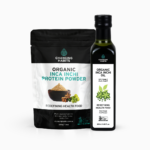I am Bee Girl and the Hum Honey story began over five years ago on our family farm in Peachester on the pristine Sunshine Coast hinterland. We are blessed to call this unique area home.
The interesting part of our story is that it has more to do with environmental conservation than farming and food production. Our farm is federally recognised as a critically endangered lowlands subtropical rainforest region, being home to an amazing array of native flora and fauna including numerous endangered frog species.
By completing a Sunshine Coast Regional Council conservation project, we were able to establish a wildlife corridor to reconnect the property’s forest to the Stanley River for the first time in 100 years. This regeneration of the natural waterway required the planting of eight growing zones from hardwood forest to riparian rainforest species. Pollination was top of mind and it was the recollection of childhood experience of eating real honeycomb fresh from the hive that turned our conversation to beekeeping and the critical role of pollinating insects in our food chain security.
Native bees are abundant on our property and our research supported the complementary cohabitation with European honeybees in a sustainable apiary size with the side benefit of being able to harvest excess honey stores for our family’s enjoyment.
Ask most beekeepers and they will tell you that they only intended to have one hive – our story is no different! News of our European honeybee hive and our organic natural practices quickly spread throughout our family and friends. This organic demand required additional hives and knowledge. I was very fortunate to find a mentor with 50+ years beekeeping experience eager to share his passion of honey bees and honey production. With Allan’s help, we were able to grow our apiary with confidence, though not without hiccups along the way, and soon after began our first commercial honey supply to a relative’s new organic wholefood store on the Sunshine Coast. The rest, they say, is Hum Honey history!
Honey the Way Nature Intended
Today we are proud to say our beekeeping practices haven’t deviated from those principles we embraced at the beginning of our beekeeping journey. We are passionate about our bee’s health and delight in bringing the changing flavours of the Sunshine Coast to you with our high quality, single apiary origin honey crafted with care on our farm using organic, natural beekeeping methods. No pesticides, no chemical residues, no antibiotics, no additives, no supplementary feeding, no hive migration, no microfiltration and never heated. Just 100% Australian, pure, raw, and natural; and tastes the way nature intended!
Although this requires significantly more time and expense compared to traditional commercial honey production, it is these conscious choices in bee husbandry and honey processing techniques that differentiates the flavour, quality, and nutritional profile of Hum Honey.
Honey is a unique food – you can’t fake it, and don’t be deceived, it is definitely not plant nectar, syrups, saps, juices or any other man or factory made concoction regardless of marketing trickery!
Honey is only produced by bees and is ingeniously stored in another unique compound found nowhere else on the planet – beeswax. This is only produced by the glands from the body of the bee herself. Honey and beeswax are two of nature’s most precious gifts.
Honey is a complex food, the only known food source to never spoil in its purest, unadulterated form and is created through the most amazing collaboration of relentless teamwork and environmental resources. The colony chooses their nectar and pollen sources from a five kilometre radius away from the hive, which is essential for the provision of both carbohydrates and proteins for their rearing of young and their own sustenance.
The magic happens during the foraging and transfer of nectar from the bee’s ‘honey stomach’ where gut enzymes merge with the nectar. Honey is the cured form, capped with beeswax after a marathon bee-wing-powered dehydration process in the beeswax comb, reducing the water content from high 80% to below 20%. With more than 25 different natural sugars that aid in digestion, honey also contains natural acids (gluconic, citric), minerals (potassium, magnesium, calcium), vitamins (thiamine, riboflavin, folic acid), proteins (amino acids, carotene, mannitol) and enzymes (invertase, catalyse, glycose oxidase) to name but a few.
We celebrate the honeybee and her evolution to naturally store excess resources, which we only harvest in sustainable quantities with gentle practices to maximise the colonies health and happiness. That’s why we chose the name Hum Honey, as only the most content bees hum!
Not All Honey is Created Equal
The flavour of honey naturally varies throughout the season depending on the ‘bees’ choice’ of floral sources. Colour, viscosity, aromas and bioactivity subsequently changes throughout the season and we choose to showcase this rather than homogenise nature with blending and microfiltration.
Temperature has a profound impact on the quality of honey, its nutritional and bioactivity, flavour, colour and pallet texture. Applying heat during the extraction processing, filtration, bottling and storage of honey is a common practice even for hobbyists. This increases hydroxymethylfurfural levels, which is the product of thermal decomposition of fructose, and is limited by both Codex and Australian standards for health considerations.
Hum Honey is never heated and may have an opaque appearance at various times throughout the year and will usually granulate, crystallize or ‘candy’ to a thick consistency after a few months. This can be easily returned to a liquid consistency by standing in sunshine or gently warming in hot water if a runny consistency is desired. If your honey remains runny throughout time it is likely not pure and/or heat treated.
Medicinal or Manuka honey, known in Australia by beekeepers as active jellybush, is sourced from Leptospermum sp. which is prevalent throughout the Sunshine Coast region. Honey from this nectar source is high in methylglyoxal (MGO), which is the active antibacterial component and an indicator of the strength of Manuka honey.
Australia has been shown through research extensively conducted by the University of Sunshine Coast to be home to not only a significantly higher quantity of bioactive Manuka species, but also plants with a higher level of bioactivity than those found and sourced from New Zealand Manuka species. Australia is currently also the only country which does not yet have Varroa destructor mites, a notifiable pest and biosecurity risk, which adversely affects the colony health leading to colony collapse without chemical intervention with miticides. Australia is renown for our clean, green food and agriculture reputation and we encourage you to select only 100% Australian honey that is pure, raw, and ideally produced with organic principles for your maximum health benefits.
May is Honey Month and we will be celebrating this year with the release of Hum Honey‘s first Australian Manuka Bioactive Honey MGO 100+ at the end of month. With our recent win at Fine Food Australia for the Best New Product Australian Made Category, we trust your experience will be like that of the judge who described their tastings of Hum Honey Cold Fusion® as a journey of the senses which reminded him of “Christmas in his mouth”!
Our family would honoured to have Hum Honey in your pantry and wish you the best of health and happiness and to always “Savour the Flavour”!








0 Comments